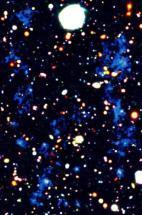
The new RTD-B will join the COSMIB team to tackle two key questions to understand the nature of our Universe. What is the dark matter made of, and what is its role in shaping and regulating the evolution of cosmic filaments? How do galaxies and cosmic filaments interact with each other and how do these interactions shape the evolution of galaxies? The expansion of the Universe leads to the formation of a network of filaments within which galaxies form. To understand the physics that regulates the evolution of these structures, we need to map the distribution of matter inside these filaments on large scales, and at the same time to obtain a detailed view of how gas is exchanged between galaxies and filaments on small scales.
Jointly with the research group COSMIB, funded by the European Research Council and Fondazione Cariplo, the new RTD-B will exploit the deepest and most detailed observations of two regions of the sky using data taken with the MUSE instrument at the Very Large Telescope and with the Hubble Space Telescope, with the goal of revealing images of the cosmic filaments and of studying the interactions with the surrounding galaxies. In tandem, the new RTD-B will map the cosmic gas on large scales using data which will be collected with the upcoming experiment WHT Enhanced Area Velocity Explorer (WEAVE). WEAVE will gather observations of half million (ten times what available nowadays) very luminous galaxies, known as “quasars”, which the Astrophysics Unit in Bicocca will analyse with advanced techniques to identify and map cosmic filaments. Combining the sensitivity of small-scale data from the Very Large Telescope and the Hubble Space Telescope with the statistics of observations on large scales provided by WEAVE, this project will produce a unique sample to answer how dark matter shapes the cosmic structures within which galaxies form and evolve exchanging gas.
The expertise in observational astrophysics of the new RTD-B will also contribute to develop a programme of innovative teaching methods in astrophysics and, more generally, to disseminate methods and principles of STEM disciplines in schools and within the general public, also thanks to the imminent arrival of a new 40 cm telescope for the use of teaching and outreach in Bicocca.